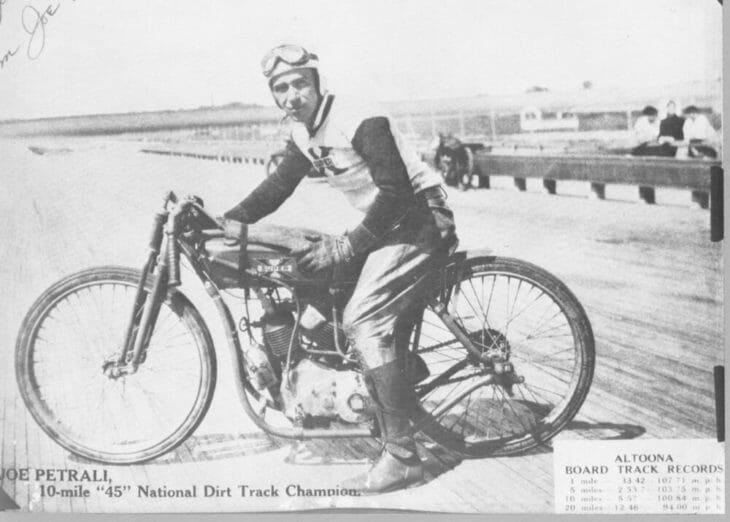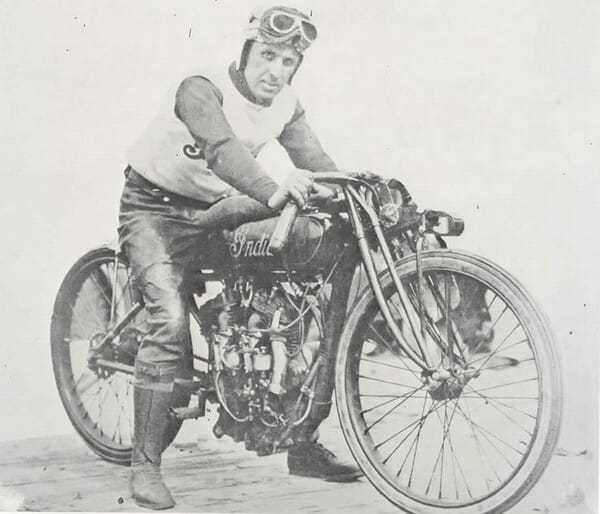Larry Lawrence | September 24, 2019
Archives: The Last of the Boards
The board track era had been over for nearly a decade, but in the mid-1920s, racing of a bygone era made one last brief comeback when the AMA held national races on the massive mile-and-a-quarter board track near Altoona, Pennsylvania.
Archives: The Last of the Boards
 A vintage postcard featuring the Altoona Board Track with a big crowd in attendance.
A vintage postcard featuring the Altoona Board Track with a big crowd in attendance.
Motorcycle racing in America during the early 1900s was primarily confined to city-to-city runs and races on bicycle velodromes. But as engines became more powerful it was clear that the small bicycle tracks were not large enough to showcase the capabilities of motorcycles.
In 1910 the Los Angeles Motordrome, built in the resort of Playa Del Ray, was the first large board track built in America. Motorcycle racing on the boards drew huge crowds and the push was on to build more across the country.
While popular, board track racing became the deadliest form of racing in the history of motorsports. Hundreds of lives were lost, both racers and spectators, during the relatively short-lived era of the boards. Yet in spite of, or perhaps partly because of the dangers, board track racing in the 1910s was one of the most popular spectator sports in America. Races attracted crowds of up to 10,000 fans. Young riders knew of the dangers, but chose to ignore them because the payoffs were so lucrative. Top rider could make $20,000 per year racing the board tracks, nearly a half-million dollars in today’s dollars.
By the end of the 1910s the board track era was largely a thing of the past. Besides the dangers of racing the boards, the tracks rapidly deteriorated and many burned down. A thrilling, but deadly chapter in American motorsports largely came to a close.
But then a group of investors, which called itself the Altoona Speedway Association, headed by a gentleman named George Long, wanted to build a racetrack that might rival Indianapolis, and they decided to build it out of wood. A site was chosen north of Altoona, in Tipton, because there was already a major highway, train and trolley stops there for a neighboring large amusement park. Over $300,000 needed to be raised to build the gigantic banked board track and the three primary business investors – Long, Robert Fluke and W.A. Morgan – took out loans from banks and also sold stocks to investors. In 1921 construction on the Altoona Board Track began.
 Joe Petrali sits on the Excelsior Super X, which he rode to several speed records on at Altoona in 1926.
Joe Petrali sits on the Excelsior Super X, which he rode to several speed records on at Altoona in 1926.
Jack Prince, famous for building many of the board tracks of the 1910s, was brought in from the West Coast to supervise the construction. It was one of the largest construction projects ever seen in the Altoona area. Prince’s plans called for four million board feet of lumber and eighty tons of nails! Hundreds of carpenters were employed. When the giant oval was completed the corners were sloped at a 32-degree angle.
The track was packed with tens of thousands of spectators when it first hosted auto races in 1922. It appeared the new track was going to be a hit and a money maker for investors. But perhaps owning to the remoteness of the circuit, deep in the Allegheny Mountains, subsequent races drew ever smaller crowds. Then came the idea to host national motorcycle races on the track in 1925. The AMA had been established in 1924 and Altoona was one of the few board track races ever sanctioned by the association.
The first motorcycle national at Altoona was held on Saturday, July 4 and a large crowd was in attendance. There was a buzz for the event since Excelsior had just debuted its new Super X and a special racing model, with a large capacity tank, was built specifically for the 100-mile national at Altoona. Red Wolverton was pegged to ride the machine. Unfortunately for Wolverton, the gas tank split, spraying him with fuel. He luckily made it back to the pits without catching himself on fire. Repairs were made and Wolverton got back into the race. The motor on the special Super X, dropped a valve 70 miles into the race. The national was won by the great Joe Petrali on a Harley-Davidson.
The event was a big enough success that the promoters right away signed on to host the race again in 1926.
The ’26 race was held on July 10, but a week before, Excelsior brought a special team to Altoona for speed record attempts with Petrali riding. Petrali set a slew of 45 cu. in. board track records that day at Altoona, including the fastest mile at 107.71 mph.
 Indian racer “Curley” Fredericks won the final motorcycle race to be held on the massive board track near Altoona, Pennsylvania.
Indian racer “Curley” Fredericks won the final motorcycle race to be held on the massive board track near Altoona, Pennsylvania.
On race weekend the weather was rainy in the area, keeping the crowds down from the year before. M.L. “Curley” Fredericks came into prominence in 1921 riding Indian motorcycles in Class A (factory) competition on dirt tracks and riding the motordrome boards across the country. In those early years as a factory rider for Indian the Denver, Coloradan proved his capabilities, winning several championships in the 61-cubic-inch class.
Fredericks came into his own in Altoona that weekend. He set a record on board a new factory Indian competition motorcycle with a special 61-cubic-inch, side-valve motor by posting a jaw-dropping 114 mph lap during the time trials. Fredricks went on to win the national and because of this feat, the engine Indian developed was designated the “Altoona” motor and remained in the Indian stable for years.
Like most board tracks the Altoona track went into disrepair. The 1926 races were the last motorcycle nationals to be held there and one of the final big nationals ever held on a board track period. The track eventually was torn down. For a time there was a dirt track at the location and then an airport. Today it’s the site of an industrial complex with a number of different businesses.
I visited the site and was told by locals that remnants of the track can still be found in the woods behind the industrial complex. While I was there a guy from one of the businesses, ORX, told me that when they were building the foundation for their warehouse, they hit the old tunnel that went under the old board track. Tons of additional concrete had to be poured to fill in the tunnel. The woods were too overgrown to attempt to find the remnants, but the gentleman from ORX said in the winter, without the foliage, you can walk into the woods and find the banking of the old speedway’s turn four.